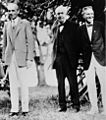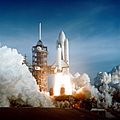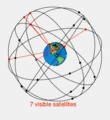Science and technology in the United States facts for kids
Science and technology in the United States has a long and exciting history. Many important people and amazing discoveries have come from the United States. The country started around a time called the Age of Enlightenment (from the late 1600s to early 1800s). During this time, thinkers in the Western world focused on using reason and logic to understand the world, rather than old beliefs. They believed that sharing ideas freely and creating useful knowledge would help everyone.
The Constitution of the United States also wanted to encourage new ideas and inventions. It gave the United States Congress the power to "promote the progress of science and useful arts." This means they could help science and inventions grow. They did this by giving inventors and writers special rights to their creations for a limited time. This led to the U.S. patent and copyright systems. These systems give creators a special right to their invention or writing for a while. After that time, the invention or writing becomes free for everyone to use. This helps new ideas and technologies spread and grow.
Images for kids
-
Henry Ford, Thomas Edison, and Harvey Firestone in Florida, 1929.
-
Alexander Graham Bell making the first New York to Chicago phone call in 1892.
-
Theoretical physicist Albert Einstein moved to the U.S. to escape danger.
-
Inventor Nikola Tesla with his "Magnifying transmitter" in Colorado.
-
Wernher von Braun with the powerful F-1 engines of the Saturn V rocket first stage.
-
Howard Hughes with his Boeing 100 airplane in the 1940s.
-
A visual example of 24 GPS satellites orbiting Earth.
-
Bill Gates and Steve Jobs at a conference in 2007.
-
Silicon Valley, a famous center for technology.
-
Engineers with three generations of Mars rovers: Sojourner, a Mars Exploration Rover (MER) test vehicle, and a test rover for Curiosity.
-
The Hubble Space Telescope seen from a Space Shuttle.
See also
 In Spanish: Ciencia y tecnología en Estados Unidos para niños
In Spanish: Ciencia y tecnología en Estados Unidos para niños















